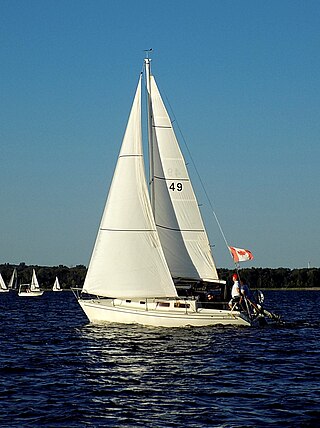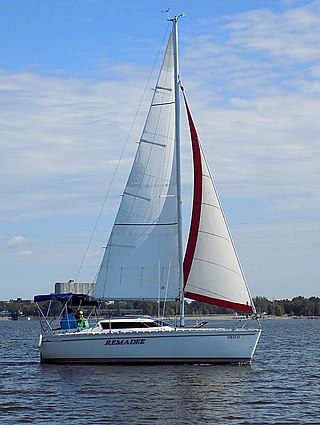The Santana 22 is an American trailerable sailboat, that was designed by Gary Mull and first built in 1966.

The Santana 20 is an American trailerable sailboat that was designed by W. Shad Turner as a day sailer, one design racer and pocket cruiser. It was first built in 1976.

The Schock 23 is an American trailerable sailboat, that was designed by Steven Schock, with a wing keel designed by Finnish engineer Reijo Salminen and first built in 1987.

The Tonic 23 is a French trailerable sailboat, that was designed by Philippe Harlé as a coastal cruiser and first built in 1985.
The Cal 21 is an American trailerable sailboat that was designed by C. William Lapworth as a cruiser and first built in 1969.
The Hughes 22 is a Canadian trailerable sailboat that was designed by Howard Hughes, the co-founder of Hughes Boat Works, as a cruiser and first built in 1971.
The Bahia 22, also called the Bahia 23, is a French trailerable sailboat that was designed by Philippe Harlé as a pocket cruiser and first built in 1983.
The Sailmaster 22 is a Dutch and American trailerable sailboat that was designed by Sparkman & Stephens as a cruiser and daysailer and first built in 1963. It was Sparkman & Stephens design #1743.
The San Juan 23 is an American trailerable sailboat that was designed by Canadian Bruce Kirby and Don Clark as a cruiser and first built in 1975.
The Santana 23 is a lightweight, 23-foot 4-inch sailboat that was designed by W. Shad Turner and manufactured by W. D. Schock Corp as a "high performance racer" and trailerable cruiser. It was first built in 1978 and remained in production through 1987, with a total of 194 units produced, though the hull was brought back in 1993 as the Santana 2023. It was produced through 1984 as the Santana 23 "D" model, commonly called the Santana 23D, with a retractable, verticle, daggerboard keel similar to racing dinghys, with a remaining 50 produced through 1987 with a traditional keel, called the Santana 23K. The hull was also used to inspire the Wavelength 24 also by Schrock, and supposedly "many other models."
The Santana 25 is an American trailerable sailboat that was designed by W. Shad Turner as an International Offshore Rule Quarter Ton class racer and first built in 1973. The boat was Turner's first design.
The Santana 2023 is a family of American trailerable sailboats that was designed by Steve Schock, with models for racing and cruising, first built in 1993.

The Wavelength 24 is an American trailerable sailboat that was designed by Paul Lindenberg as a Midget Ocean Racing Club (MORC) racer and first built in 1982.
The Santana 228 is an American sailboat that was designed by W. Shad Turner as a cruiser and first built in 1978.
The Santana 28 is an American sailboat that was designed by W. Shad Turner as a cruiser and first built in 1976.
The Santana 26 is an American trailerable sailboat that was designed by W. D. Schock Corp's in-house designer, Seymour Paul, as a cruiser and first built in 1971.
The Santana 35 is an American sailboat that was designed by W. Shad Turner as a racer-cruiser and first built in 1978.
The Santana 525 is an American sailboat that was designed by W. Shad Turner as a one design and International Offshore Rule Quarter Ton class racer-cruiser and first built in 1977.
The Schock 25 is an American trailerable sailboat that was designed by W. D. Schock Corp's in-house designer, Seymour Paul as a day sailer and first built in 1961.
The Schock 35 is an American sailboat that was designed by W. Shad Turner as a racer-cruiser and first built in 1984.




